Hole in the Clouds
Oct 31, 2010
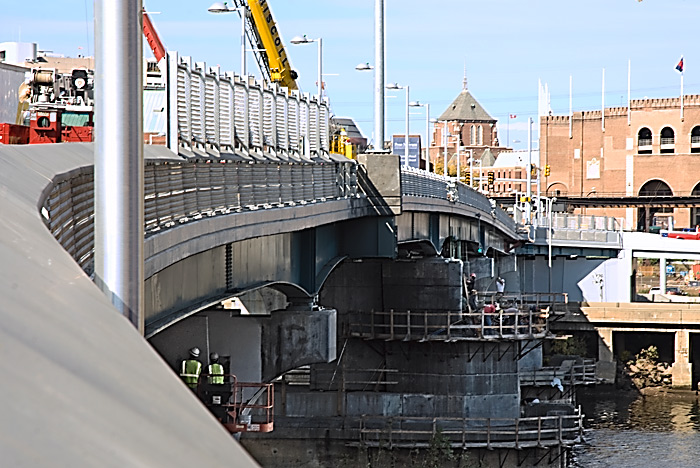
Two years ago, when they demolished the old South Street Bridge over the Schuylkill River, it was in such bad shape, I'm told, that chunks of its concrete were falling onto the expressway that passes underneath.
A week from Monday, this new South Street Bridge is scheduled to open, restoring a direct route from our neighborhood to the University of Pennsylvania across the river. The little flag near the right edge of the picture is flying over Penn's football stadium.
Looks like there's still a little work to be finished up in this next week. But they say they'll cut the ribbon right on schedule.
cityscape
Philadelphia
Schuylkill River
bridge
construction
Feb 25, 2013
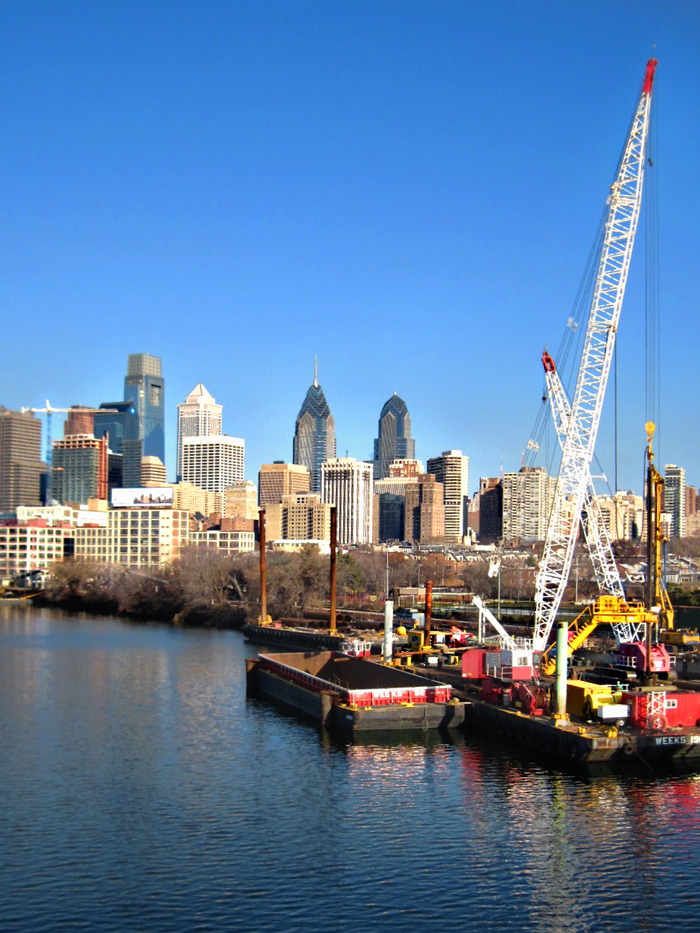 Yesterday, we caught the view from New York City's High Line rails-to-trails boardwalk, a park that winds along the western edge of lower Manhattan, thirty feet up in the sky.
Yesterday, we caught the view from New York City's High Line rails-to-trails boardwalk, a park that winds along the western edge of lower Manhattan, thirty feet up in the sky.
Today's glimpse of a tracks-to-boardwalk project is in Philadelphia, alongside the Schuylkill River, where barge-mounted heavy equipment is currently driving pilings into the riverbed for a boardwalk that will soar out over the water to extend an existing twenty-plus-mile asphalt biking and walking path.
The asphalt path follows an abandoned railroad bed downriver from Valley Forge past Fairmount Park and the Philadelphia Art Museum and on into Center City. But at Locust Street, the trail ends abruptly, crowded off the riverbank by half a dozen railroad lines that are definitely not-yet-abandoned.
The plan is to extend the path southward by snaking it out over the river as a boardwalk with observation platforms and maybe some fishing decks. (Although the Schuylkill is a bit shy of what you'd call a pristine river, there are definitely fish swimming in it, and they are catchable, if not eatable.)
After about half a mile over water, the new boardwalk will pass under the South Street Bridge and then curve back onto dry land for the remainder of its route. It will terminate in southwest Philly at Bartram's Gardens, an eighteenth-century homestead where America's earliest botanists planted the New World's first collection of botanical curiosities.
Planned completion date for the boardwalk is . . . early 2013, or so it is written. Whenever.
cityscape
railroad
Philadelphia
work
Schuylkill River
skyline
crane
barge
(Image credit: Tina Lackeos)
Oct 9, 2013
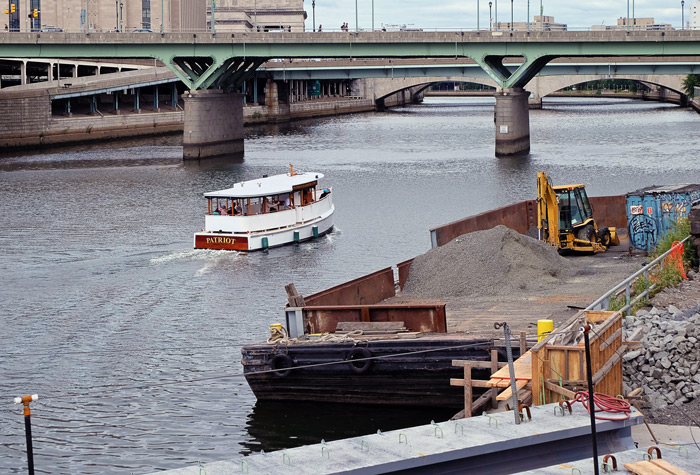 The little Patriot tour boat chugs up the Schuylkill toward the Walnut and Chestnut Street bridges.
The little Patriot tour boat chugs up the Schuylkill toward the Walnut and Chestnut Street bridges.
Visible in the lower righthand corner is construction work on a new boardwalk which will extend the Schuylkill Banks foot path and bike trail out over the river from Center City toward South Philly. "They" say the boardwalk should open in about a year.
cityscape
work
Schuylkill River
boat
Philly
barge
bridges
(Image credit: Little Fuji)
Feb 9, 2014
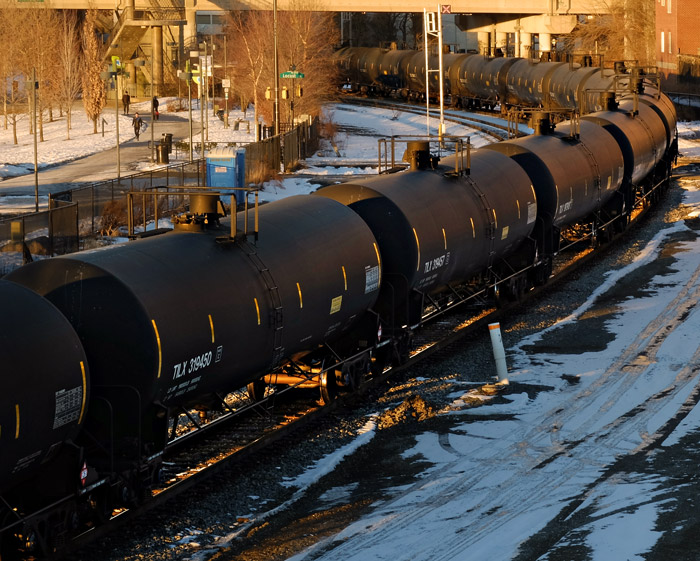 Sadly, what this train is hauling is the kind of stuff that keeps us warm. We have to do something about this.
Sadly, what this train is hauling is the kind of stuff that keeps us warm. We have to do something about this.
train
Schuylkill River
Philly
Schuylkill Banks
Locust Street
(Image credit: Little Fuji)
Jul 23, 2014
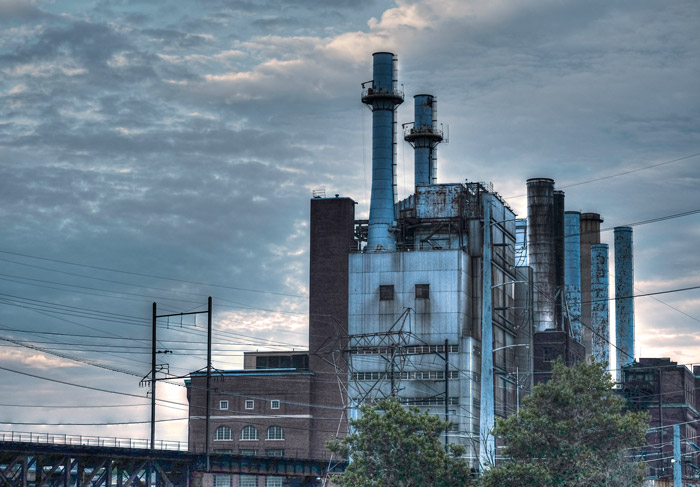 At this power plant at the edge of the neighborhood, the smokestacks that once belched day and night have been quiet now for a couple of years.
At this power plant at the edge of the neighborhood, the smokestacks that once belched day and night have been quiet now for a couple of years.
Power is still generated here at the Schuylkill complex on Grays Ferry Road, but at a newer facility immediately behind the one pictured above. Veolia Energy bought the newer part of the plant from Philadelphia's municipal electric company and converted its fuel source from oil to natural gas; that single modification reduced greenhouse gas emissions for the city as a whole, it is said, by almost 2 percent, equivalent to taking 60,000 cars off the road.
Veolia makes steam here for center city Philadelphia's centralized heating. And it does release a little smoke, not from these stacks but from a chimney behind them, not visible in the picture.
Schuylkill River
neighborhood
factory
Philly
PECO
(Image credit: Fuji T)
Dec 31, 2014
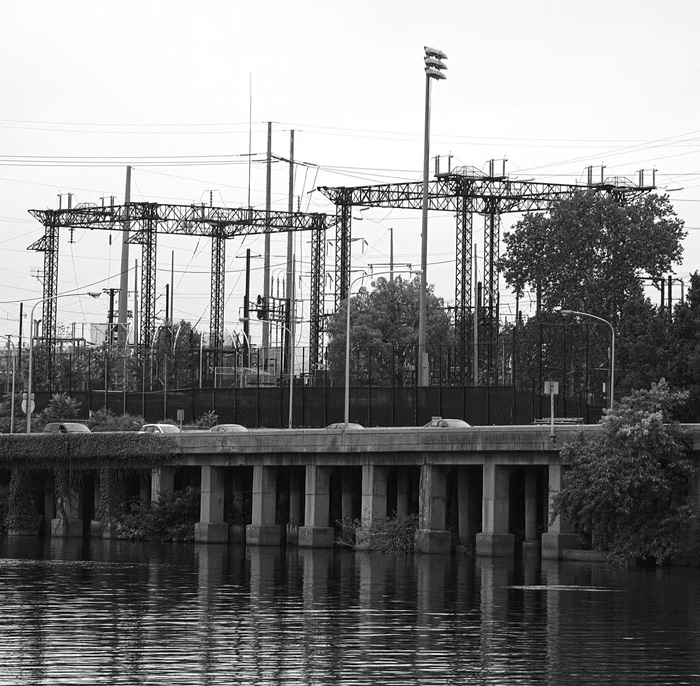 The Schuylkill Expressway, as glimpsed from across the river in South Philly.
The Schuylkill Expressway, as glimpsed from across the river in South Philly.
cityscape
Schuylkill River
infrastructure
Philly
(Image credit: Fuji T)
Feb 25, 2016
 In the mid-eighteenth century, Ben Franklin's good friend John Bartram was a nurseryman, with a plant and seed business on a few acres across the Schuylkill River from Phladelphia. This is the view today from Bartram's estate, which is now owned by the city.
In the mid-eighteenth century, Ben Franklin's good friend John Bartram was a nurseryman, with a plant and seed business on a few acres across the Schuylkill River from Phladelphia. This is the view today from Bartram's estate, which is now owned by the city.
The oil tanks are part of the largest refinery complex in the northeast, recently acquired from Sunoco by an investment fund that operates it as Philadelphia Energy Solutions. This year's low oil prices don't seem to hurt the storage-and-refinery end of the oil business; PES says it has expanded its operation locally to employ more than 1,000 people and is trying to acquire a storage facility in North Dakota.
Bartram had an international reputation as a botanist, collecting seeds and plant specimens from all over the thirteen colonies and beyond, from Florida to Lake Ontario. Much of his traveling was by foot. He sent unique New World plants to London for the king's botanists there; they in turn sent him English plants that might or might not be suitable for American climes, including some trees and shrubs that survive today in Bartram's garden.
His son Bill continued the nursery business and also wrote a best-selling travelogue about plant-collecting adventures. Bill's niece Ann then took over the place and expanded it to include ten greenhouses and many acres of nursery gardens; in 1850, however, Ann and her husband Bob Carr ran out of money and had to sell the place.
landscape
oil
Schuylkill River
skyline
industry
Sunoco
Philadelphia Energy Solutions
John Bartram
Mar 28, 2016
 This sketch from an 1878 Philadelphia city directory shows the factory and storage yard of Williams Marble & Slate Manufacturing Company. It's the building we live in these days; a long time ago, perhaps in the 1920s, the factory was converted to residential use and divided into twelve apartments. The stable and storage sheds were torn down and the land sold to a rowhouse developer. The industrial presence in our part of town near the Schuylkill River has slipped into an industrial past.
This sketch from an 1878 Philadelphia city directory shows the factory and storage yard of Williams Marble & Slate Manufacturing Company. It's the building we live in these days; a long time ago, perhaps in the 1920s, the factory was converted to residential use and divided into twelve apartments. The stable and storage sheds were torn down and the land sold to a rowhouse developer. The industrial presence in our part of town near the Schuylkill River has slipped into an industrial past.
Williams was once a thriving stone works, specializing in slate mantelpieces and stovetops. In 1876, it exhibited its products at the Centennial Columbian Exhibition, America's first World Fair. The slate and marble were quarried in the mountains of northeast Pennsylvania and floated downs the Schuylkill on barges to Philly's emerging heavy-industry area along the river–basically, the young city's backyard. Wharves and workyards hereabouts handled coal, building stone, and brick-clay from off the barges, and Irish immigrants poured into the neighborhood to work on the docks and in the factories.
All the factories are gone now. The brickyard is a park and community garden.
We live on the second floor, in the corner with the big chimney.
Philadelphia
Schuylkill River
factory
Fitler Square
Williams Marble & Slate
1876







 This sketch from an 1878 Philadelphia city directory shows the factory and storage yard of Williams Marble & Slate Manufacturing Company. It's the building we live in these days; a long time ago, perhaps in the 1920s, the factory was converted to residential use and divided into twelve apartments. The stable and storage sheds were torn down and the land sold to a rowhouse developer. The industrial presence in our part of town near the Schuylkill River has slipped into an industrial past.
This sketch from an 1878 Philadelphia city directory shows the factory and storage yard of Williams Marble & Slate Manufacturing Company. It's the building we live in these days; a long time ago, perhaps in the 1920s, the factory was converted to residential use and divided into twelve apartments. The stable and storage sheds were torn down and the land sold to a rowhouse developer. The industrial presence in our part of town near the Schuylkill River has slipped into an industrial past.